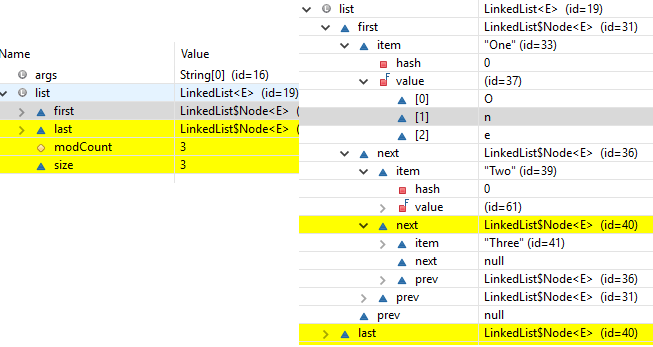LinkedList– Internal implementation
-
Underlying data structure is DoubleLinkedList
-
Insertion order is preserved
-
Duplicates are allowed
-
Heterogeneous objects are allowed
-
Null insertion is allowed
-
LinkedList implements Serializable & Clonable interfaces but not RandomAccess
-
Best Choice for Insertion/Deletion, Worst for Retrieval operation
| void addFirst(Object o)
void addLast(Object o)| Object getFirst()
Object getLast()| Object removeFirst()
Object removeLast() |
|—————————–|———————–|————————–|

public class LinkedListDemo {
public static void main(String[] args) {
LinkedList l = new LinkedList<>();
l.add("A");
l.add(10);
l.add("A");
l.add(null);
System.out.println(l); // [A, 10, A, null]
l.set(0, "Satya"); // replaces
System.out.println(l); // [Satya, 10, A, null]
l.add(0, "Johnny"); // just add
System.out.println(l); // [Johnny, Satya, 10, A, null]
l.removeFirst();
System.out.println(l); // [Satya, 10, A, null]
System.out.println(l.getFirst());// Satya
}
}
Implementation
1.LinkedList class in Java implements List and Deque interfaces and LinkedList implements it using Doubly LinkedList
2.In the implementation of the LinkedList class in Java there is a private class Node which provides the structure for a node in a doubly linked list.
-
It has -item” variable for holding the value
-
and two reference to Node class itself for connecting to next and previous nodes.
private static class Node<E> {
E item;
Node<E> next;
Node<E> prev;
Node(Node<E> prev, E element, Node<E> next) {
this.item = element;
this.next = next;
this.prev = prev;
}
}

3.Reference to Previous Element of first node and Reference To Next Element of last node are null as there will be no elements before the first node and after the last node
4.You can insert the elements at both the ends and also in the middle of the LinkedList. Below is the list of methods for insertion operations.
5.If you call the regular add() method or addLast() method internally linkLast() method is called
/** * Links e as last element. */
void linkLast(E e) {
final Node<E> l = last;
final Node<E> newNode = new Node<>(l, e, null);
last = newNode;
if (l == null)
first = newNode;
else
l.next = newNode;
size++;
modCount++;
}
6.If you call addFirst() method internally linkFirst() method is called.
private void linkFirst(E e) {
final Node<E> f = first;
final Node<E> newNode = new Node<>(null, e, f);
first = newNode;
if (f == null)
last = newNode;
else
f.prev = newNode;
size++;
7.Insertion and removal operations in LinkedList are faster than the ArrayList. Because in LinkedList, there is no need to shift the elements after each insertion and removal, because we only add elements at First or Last no in-between. only references of next and previous elements need to be changed.
8.Retrieval of the elements is very slow in LinkedList as compared to ArrayList. Because in LinkedList, you should traverse from beginning or end (whichever is closer to the element) to reach the element.
public class LinkedListDemo {
public static void main(String[] args) {
LinkedList<String> list = new LinkedList<>();
list.add("One");
list.add("Two");
list.add("Three");
System.out.println(list);
}
}
